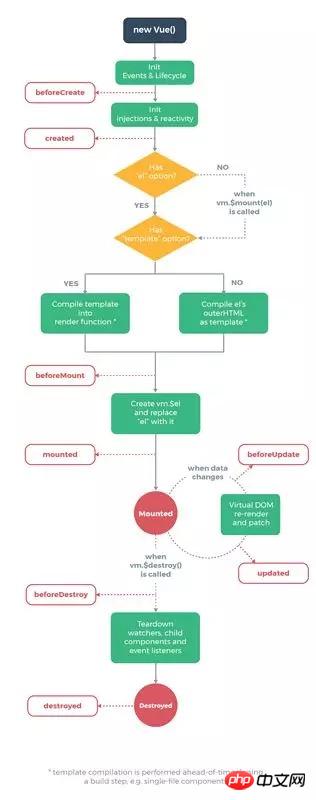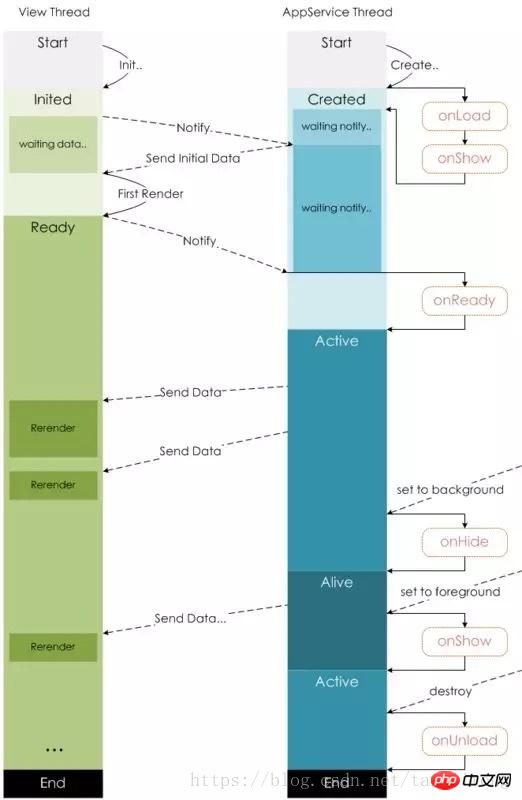Vue 和微信小程式的差異有哪些?比較分析
一、生命週期
先貼兩張圖:
vue生命週期

小程式生命週期

# 相較之下,小程式的鉤子函數要簡單得多。
vue的鉤子函數在跳轉新頁面時,鉤子函數都會觸發,但是小程式的鉤子函數,頁面不同的跳躍方式,觸發的鉤子並不一樣。 onLoad:頁面載入
一個頁面只會呼叫一次,可以在 onLoad 中取得開啟目前頁面所呼叫的 query 參數。
onShow:頁面顯示
每次開啟頁面都會呼叫一次。
onReady:頁面初次渲染完成
一個頁面只會呼叫一次,代表頁面已經準備妥當,可以和視圖層互動。
對介面的設定如 wx.setNavigationBarTitle請在 onReady之後設定。詳見生命週期。
onHide:頁面隱藏
當 navigateTo或底部tab切換時呼叫。
onUnload:頁面卸載
當 redirectTo或 navigateBack的時候呼叫。
資料請求
在頁面載入請求資料時,兩者鉤子的使用有些類似,vue一般會在created或mounted中請求數據,而在小程序,會在onLoad或onShow中請求數據。
二、資料綁定
vue:vue動態綁定一個變數的值為元素的某個屬性的時候,會在變數前面加上冒號: ,例:
- 小程式:綁定某個變數的值為元素屬性時,會用兩個大括號括起來,如果不加括號,為被認為是字串。範例:
<img src="/static/imghw/default1.png" data-src="imgSrc" class="lazy" :/ alt="Vue 和微信小程式的差異有哪些?比較分析" >
登入後複製
<image src="{{imgSrc}}"></image>三、清單渲染
直接貼程式碼,兩者還是有些相似:
##vue:
<ul id="example-1">
<li v-for="item in items">
{{ item.message }}
</li>
</ul>
var example1 = new Vue({
el: '#example-1',
data: {
items: [
{ message: 'Foo' },
{ message: 'Bar' }
]
}
})小程式:
#
Page({
data: {
items: [
{ message: 'Foo' },
{ message: 'Bar' }
]
}
})
<text wx:for="{{items}}">{{item}}</text>四、顯示與隱藏元素#在 ##vue中,使用
v-if 和v-show控制元素的顯示和隱藏。 小程式中,使用
和 hidden控制元素的顯示和隱藏。
vue:使用
v-on:event綁定事件,或使用@event在綁定事件,例如:
<button v-on:click="counter += 1">Add 1</button> <button v-on:click.stop="counter+=1">Add1</button> //阻止事件冒泡
小程式中,全用
bindtap(bind event),或catchtap(catch event)綁定定事件,例如:
<button bindtap="noWork">明天不上班</button> <button catchtap="noWork">明天不上班</button> //阻止事件冒泡
1、設定值
在vue中,只需要再表單元素上加上
v-model,然後再綁定data中對應的一個值,當表單元素內容改變時, data中對應的值也會隨之改變,這是vue非常nice的一點。
<p id="app">
<input v-model="reason" placeholder="填写理由" class='reason'/>
</p>
new Vue({
el: '#app',
data: {
reason:''
}
})但是在小程式中,卻沒有這個功能。那怎麼辦呢?
當表單內容變更時,會觸發表單元素上綁定的方法,然後在該方法中,透過
this.setData({key:value})來將表單上的值賦值給data中的對應值。 下面是程式碼,可以感受一下:
<input bindinput="bindReason" placeholder="填写理由" class='reason' value='{{reason}}' name="reason" />
Page({
data:{
reason:''
},
bindReason(e) {
this.setData({
reason: e.detail.value
})
}
})當頁面表單元素很多的時候,更改值就是一件體力活了。和小程式一比較,vue的
v-model簡直爽的不要不要的。 2、取值
vue中,透過
this.reason取值。 小程式中,透過
取值。
在vue中,綁定事件傳參挺簡單,只需要在觸發事件的方法中,把需要傳遞的資料作為形參傳入就可以了,例如:
<button @click="say('明天不上班')"></button>
new Vue({
el: '#app',
methods:{
say(arg){
consloe.log(arg)
}
}
})在
小程式中,不能直接在綁定事件的方法中傳入參數,需要將參數作為屬性值,綁定到元素上的data-屬性上,然後在方法中,透過e.currentTarget.dataset.*的方式取得,從而完成參數的傳遞,很麻煩有沒有...
<view class='tr' bindtap='toApprove' data-id="{{item.id}}"></view>
Page({
data:{
reason:''
},
toApprove(e) {
let id = e.currentTarget.dataset.id;
}
})##1、子元件的使用
在vue中,需要:1、寫子元件2、在需要使用的父元件中透過import
引入3、在vue
components中註冊4、在範本中使用
//子组件 bar.vue
<template>
<p class="search-box">
<p @click="say" :title="title" class="icon-dismiss"></p>
</p>
</template>
<script>
export default{
props:{
title:{
type:String,
default:''
}
}
},
methods:{
say(){
console.log('明天不上班');
this.$emit('helloWorld')
}
}
</script>
// 父组件 foo.vue
<template>
<p class="container">
<bar :title="title" @helloWorld="helloWorld"></bar>
</p>
</template>
<script>
import Bar from './bar.vue'
export default{
data:{
title:"我是标题"
},
methods:{
helloWorld(){
console.log('我接收到子组件传递的事件了')
}
},
components:{
Bar
}
</script>json
檔案中,將該檔案宣告為元件 {
"component": true
}3、在需要引進的父元件的json文件中,在usingComponents填入引入元件的元件名稱以及路徑
"usingComponents": {
"tab-bar": "../../components/tabBar/tabBar"
}4、在父组件中,直接引入即可
<tab-bar currentpage="index"></tab-bar>
具体代码:
// 子组件
<!--components/tabBar/tabBar.wxml-->
<view class='tabbar-wrapper'>
<view class='left-bar {{currentpage==="index"?"active":""}}' bindtap='jumpToIndex'>
<text class='iconfont icon-shouye'></text>
<view>首页</view>
</view>
<view class='right-bar {{currentpage==="setting"?"active":""}}' bindtap='jumpToSetting'>
<text class='iconfont icon-shezhi'></text>
<view>设置</view>
</view>
</view>2、父子组件间通信
在vue中
父组件向子组件传递数据,只需要在子组件通过 v-bind传入一个值,在子组件中,通过 props接收,即可完成数据的传递,示例:
// 父组件 foo.vue
<template>
<p class="container">
<bar :title="title"></bar>
</p>
</template>
<script>
import Bar from './bar.vue'
export default{
data:{
title:"我是标题"
},components:{
Bar
}
</script>
// 子组件bar.vue
<template>
<p class="search-box">
<p :title="title" ></p>
</p>
</template>
<script>
export default{
props:{
title:{
type:String,
default:''
}
}
}
</script>子组件和父组件通信可以通过 this.$emit将方法和数据传递给父组件。
在小程序中
父组件向子组件通信和vue类似,但是小程序没有通过 v-bind,而是直接将值赋值给一个变量,如下:
- 此处, “index”就是要向子组件传递的值。
<tab-bar currentpage="index"></tab-bar>
登入後複製登入後複製
在子组件 properties中,接收传递的值。
properties: {
// 弹窗标题
currentpage: { // 属性名
type: String, // 类型(必填),目前接受的类型包括:String, Number, Boolean, Object, Array, null(表示任意类型)
value: 'index' // 属性初始值(可选),如果未指定则会根据类型选择一个
}
}子组件向父组件通信和 vue也很类似,代码如下:
//子组件中
methods: {
// 传递给父组件
cancelBut: function (e) {
var that = this;
var myEventDetail = { pickerShow: false, type: 'cancel' } // detail对象,提供给事件监听函数
this.triggerEvent('myevent', myEventDetail) //myevent自定义名称事件,父组件中使用
},
}
//父组件中
<bar bind:myevent="toggleToast"></bar>
// 获取子组件信息
toggleToast(e){
console.log(e.detail)
}如果父组件想要调用子组件的方法
vue会给子组件添加一个 ref属性,通过 this.$refs.ref的值便可以获取到该子组件,然后便可以调用子组件中的任意方法,例如:
//子组件 <bar ref="bar"></bar> //父组件 this.$ref.bar.子组件的方法
小程序是给子组件添加 id或者 class,然后通过 this.selectComponent找到子组件,然后再调用子组件的方法,示例:
//子组件 <bar id="bar"></bar> // 父组件 this.selectComponent('#id').syaHello()
小程序和vue在这点上太相似了,有木有。。
相关推荐:
以上是Vue 和微信小程式的差異有哪些?比較分析的詳細內容。更多資訊請關注PHP中文網其他相關文章!

熱AI工具

Undresser.AI Undress
人工智慧驅動的應用程序,用於創建逼真的裸體照片

AI Clothes Remover
用於從照片中去除衣服的線上人工智慧工具。

Undress AI Tool
免費脫衣圖片

Clothoff.io
AI脫衣器

Video Face Swap
使用我們完全免費的人工智慧換臉工具,輕鬆在任何影片中換臉!

熱門文章

熱工具

記事本++7.3.1
好用且免費的程式碼編輯器

SublimeText3漢化版
中文版,非常好用

禪工作室 13.0.1
強大的PHP整合開發環境

Dreamweaver CS6
視覺化網頁開發工具

SublimeText3 Mac版
神級程式碼編輯軟體(SublimeText3)




